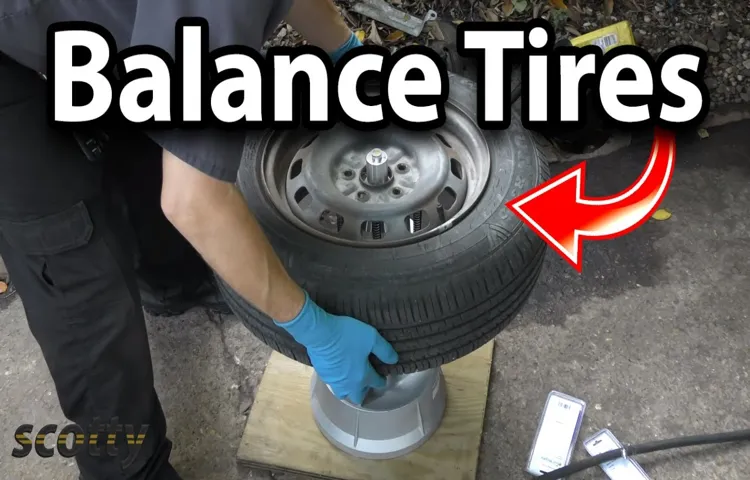Driving your car is one of the things that gives you a good sense of freedom and independence. But with this comes the responsibility of maintaining it from time to time. One of the maintenance tasks that often gets overlooked is tire balancing.
The cost of tire balancing may seem like an extra expense, but in the long run, it can save you money and keep you safe on the road. In this blog post, we’ll dive into the nitty-gritty of tire balancing and why it is essential for your car’s overall performance and longevity. So, buckle up and let’s get started!
Table of Contents
What Is Tire Balancing?
If you’re wondering how much tire balancing costs, it can depend on several factors such as where you live and the type of vehicle you have. Tire balancing is the process of adding or subtracting weight from your tires to ensure that they are evenly distributed. This is important because unbalanced tires can lead to uneven tread wear, vibrations while driving, and even reduced fuel efficiency.
The average cost of tire balancing can range from $10 to $30 per tire, depending on your location and the auto shop you choose. It’s important to have your tires balanced regularly to extend the life of your tires and improve your driving experience. If you’re noticing any vibrations or uneven wear on your tires, it may be time for a tire balancing service.
What Happens During Tire Balancing?
Tire balancing is a crucial maintenance task that is often overlooked by car owners. It involves adjusting the weight distribution of your car’s tires to ensure even wear and tear, which ultimately leads to a smoother ride and better fuel efficiency. During the balancing process, a technician will mount your car’s tires onto a balancing machine and spin them at high speeds.
The machine will then measure any imbalances in the tire and recommend corrective measures. These measures include adding weights to the wheel rim or adjusting tire pressure to achieve the optimal balance. By balancing your tires regularly, you can avoid costly repairs and ensure your car’s safety on the road.

Why Is Tire Balancing Important?
Tire balancing is a crucial aspect of vehicle maintenance that is often overlooked. It involves making sure that the weight of your tires is distributed evenly, which helps to prevent excessive wear and tear over time. Essentially, it involves adding small weights to the tire’s rim to achieve optimal balance.
When tires are unbalanced, it can cause vibrations, which can affect the handling and overall safety of your vehicle. In addition to creating an uncomfortable ride, unbalanced tires can also cause uneven tread wear, which may lead to premature tire failure. This is especially important for high-performance vehicles, as even a slight imbalance can negatively impact their driving experience.
Overall, making sure your tires are properly balanced is a simple and cost-effective way to prolong the lifespan of your tires, maintain fuel efficiency, and ensure your safety on the road.
Factors That Affect the Cost of Tire Balancing
If you’re wondering how much tire balancing costs, there are a few factors that can affect the price. First, the make and model of your vehicle will play a role in determining the overall cost. Certain cars may require special equipment or techniques to balance their tires, which could increase the price.
Additionally, the size and type of tires you have can impact the cost. Larger tires will generally cost more to balance, and if you have high-performance or specialized tires, the price may go up as well. Finally, the location of the service provider and their level of expertise can also influence the cost.
If you opt for a higher-end service provider in a big city, you may end up paying more for their skill and reputation. Ultimately, the cost of tire balancing can vary widely, so it’s a good idea to shop around and compare prices before settling on a provider.
Type of Vehicle
When it comes to tire balancing, the type of vehicle you own can significantly impact the cost. One reason for this is the size and weight of your vehicle. Larger, heavier vehicles such as trucks and SUVs require larger and heavier tires, which can be more challenging to balance and require more time and effort.
This can lead to a higher cost for tire balancing services. Additionally, the type of tires your vehicle uses can impact the cost. High-performance tires, for example, tend to cost more to balance due to their unique construction and tread patterns.
On the other hand, standard tires typically cost less to balance. If you own a specialty vehicle with unique tires, it’s essential to find a tire balancing service that has experience working with your vehicle’s specific requirements. Overall, when it comes to tire balancing, it’s important to consider the type of vehicle you own and the tires it uses to ensure you receive accurate cost estimates and quality service.
Type of Tires
When it comes to tire balancing, there are several factors that can affect the cost of the service. One of the primary factors is the type of tire. Different types of tires require different methods and tools for balancing, which can impact the final cost.
Performance tires, for example, are typically more expensive to balance than standard all-season tires. This is because performance tires require a higher level of accuracy and precision in the balancing process. Additionally, the size and weight of the tire can also impact the cost of balancing.
Larger and heavier tires may require more time and effort to balance properly, leading to a higher cost. Overall, it’s important to consider the type of tire you have and how that may impact the cost of balancing, as well as the potential long-term benefits of ensuring your tires are properly balanced for optimal performance and safety on the road.
Location
Location Tire balancing is an important service that improves the performance and extends the life of your tires. However, the cost of tire balancing varies depending on several factors, including location. The cost of tire balancing is relatively low in rural areas compared to urban areas.
This is because urban areas have higher operating costs, such as rent and labor, which result in higher service fees. Additionally, the demand for tire balancing services is higher in urban areas, resulting in higher prices. On the other hand, rural areas have fewer tire balancing service providers, which leads to lower prices due to competition.
Therefore, if you live in an urban area, you may expect to pay more for tire balancing services than someone living in a rural area. However, it’s important to note that choosing a reputable tire balancing service provider based on quality and expertise is crucial regardless of location.
Typical Cost of Tire Balancing
Are you curious about the cost of tire balancing? Well, the answer to that depends on several factors. The average cost of tire balancing ranges from $15 to $75 per tire. The price varies depending on where you live, the type of tire you have, and the kind of vehicle you drive.
On the low end, you can expect to pay around $15 per tire, but on the high end, the price may exceed $75 per tire. Some shops offer tire balancing services for free if you purchase new tires from them, so it’s worth looking into if you need new tires anyway. Keep in mind that balancing your tires is crucial for your safety on the road and for ensuring that your vehicle’s tires last as long as possible.
So, if you’re due for tire balancing, don’t skip it to save a few bucks.
National Average
When it comes to tire balancing, the national average cost can vary depending on several factors, including the type of vehicle and where you live. Nonetheless, the typical cost you can expect to pay is around $40 to $75 per tire. However, this cost does not include any additional fees, such as taxes, disposal fees, or any necessary repairs.
It’s always best to ask for a quote from your local service center or mechanic to receive an accurate estimate. Keep in mind that tire balancing is critical for ensuring a smooth and safe ride. Unbalanced tires can cause uneven tread wear, vibration, and reduce overall vehicle performance.
Thus, it’s essential to maintain proper tire balance and have your tires checked regularly. Overall, tire balancing is a small price to pay to keep your vehicle running at its best and avoid more expensive repairs down the road.
Range of Cost
When it comes to tire balancing, the cost can vary depending on a few factors. The typical cost for a tire balancing service ranges from around $10 to $30 per tire. However, this cost can vary depending on where you live and the type of vehicle you have.
Some shops may charge a higher fee for luxury or high-performance vehicles because they require more specialized equipment and expertise. Additionally, the type of balancing method used can also affect the cost. Traditional spin balancing may cost less, while newer methods like road force balancing may have a higher price tag.
It’s important to shop around and compare prices from different shops to ensure you’re getting a fair deal. And although cost is an important consideration, it’s also important to choose a reliable and experienced technician who can ensure your tires are properly balanced to improve your vehicle’s safety and performance on the road.
When Should You Get Your Tires Balanced?
If you’re experiencing vibration or shaking in your steering wheel or seat, it may be time for a tire balance. Tire balancing ensures that the weight of the tire is distributed evenly across the rim and can improve the overall performance and longevity of your tires. How much is tire balancing? The cost can vary depending on your location and the type of vehicle you have, but it typically ranges from $20 to $100 per tire.
It’s recommended to get your tires balanced every 5,000 to 6,000 miles or whenever you get new tires installed. Additionally, it’s important to get your tires balanced after hitting a pothole or curb, as this can cause your tires to become unbalanced and lead to uneven wear, decreased fuel efficiency, and potentially dangerous driving conditions. Remember, balancing your tires is a simple and affordable solution that can improve your driving experience and protect your investment in your vehicle’s tires.
Conclusion
In the world of tire balancing, the cost can vary depending on different factors such as skill and location. But let’s face it, having properly balanced tires is essential for driving comfort, improved safety, and longer tire wear. So, the real question is not how much is tire balancing, but rather how much are you willing to invest in the safety and overall performance of your vehicle?”
FAQs
What is tire balancing?
Tire balancing is the process of evenly distributing the weight of a tire and rim assembly for smooth operation.
When should tire balancing be done?
Tire balancing should be done when new tires are installed, if there’s vibration or shimmy while driving, or when rotating tires.
How often should tire balancing be done?
Tire balancing should be done every 5,000 to 6,000 miles or every time you have your tires rotated.
How much does tire balancing cost?
The cost of tire balancing typically ranges from $10 to $20 per tire, depending on the location and service provider.
Is tire balancing necessary for all vehicles?
Yes, tire balancing is necessary for all vehicles to ensure safe and comfortable operation.
What are the signs of an unbalanced tire?
Signs of an unbalanced tire include vibration or shimmy in the steering wheel, uneven tire wear, and a bouncing sensation while driving.
Can an unbalanced tire cause damage to a vehicle?
Yes, an unbalanced tire can cause damage to a vehicle’s suspension, steering, and other parts if left unchecked.



